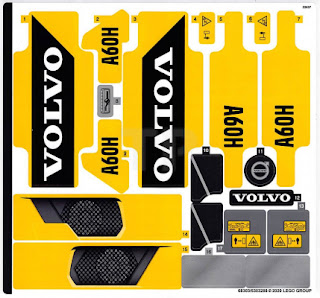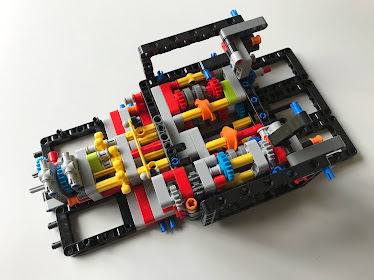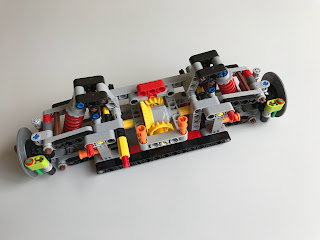Anyone with an interest in Lego will know that the company has positioned itself in the marketplace as a purveyor of 'premium product'. That is to say, it's stupidly expensive. But now, with everything that's going on in the world; economies still reeling from Covid and the war in Ukraine driving up prices of food and energy (among other things), the Lego Group have decided that they need to alter their prices.
Upwards.
And not just a 'bit' upwards.
A lot.
Are Lego on their uppers? Are they scrabbling down the back of the undoubtedly cool, Scandinavian designer sofas at Billund, looking for a few Krone so that they can keep the lights on? Have sales plummeted so far that they need to put prices up rather than lay off staff?
Well, no.
I'm no economist, and I'm willing to accept that there's more to a set of annual accounts than a few easy-to-pick-off highlights, but facts are facts. So let's take a look at a few numbers from the Lego Group's 2021 annual report.
Consumer sales up 22%. Doesn't say what it was up from, or up to, but given that Lego is the largest toy company on the planet, I'm guessing it was from 'big' to 'even bigger'.
Revenue grew 27%. To £6.29bn. That was the Gross Domestic Product of Kyrgyzstan in 2017. But every company has costs, right? Revenue's nothing if your costs exceed it. It's all about the bottom line. It's all about net profit. What were you left with, once the bills were paid, once the taxman was happy, once something had been set aside for the future?
In 2020, Lego had a net profit of £1.1 billion. Must have taken a hit in 2021 to force them to put their prices up. Right? Right?
Actually, no. Last year they cleared £1.5 billion. Which, if my 'back of an envelope' maths is correct, represents something like a 36% uplift in profit for the year.
I can see why they needed to put those prices up...
Well, actually, I can. Or at least I've seen one take on it, from an accountant, that sort of, almost, kind of justifies the rises.
It's the economy, stupid. (1)
There was an article on Bricknerd recently, written by an economist called Michael A. Craven, Ph.D which was long and complicated, but after reading it a few times, I got the general gist. If you're at all interested, I highly recommend that you nip over to that very-excellent site and read it for yourself. In the meantime, I'm going to summarise - in a fairly crude fashion - some of the highlights. Then I'm going to suggest a few ways in which LEGO might act to reduce the prices.
Price rises, if not driven by sheer naked greed for more money (which does happen) are mostly driven by inflation. When a company's costs go up, they've basically got two options:
1. Sell you less of the thing for the same price.
2. Sell you the same thing for more money.
The first is known as 'Shrinkflation'. You've probably seen it with things like Jaffa Cakes. The price is basically the same as it's been for some time, but whereas you used to get twelve cakes in a pack, now you only get ten. It's a relatively subtle way for companies to pass along price rises without making it blindingly obvious. The alternative is, of course, to just whack the price up, which is what LEGO appear to be doing with a significant tranche of its products. So what did Mr Craven have to say about this?
Well, broadly speaking, inflation is going on a lot the time, but it tends to be a slow and subtle rise. We do also have periods of recession, but for the most part, we have low inflation and prices creep up. Now a typical LEGO set has a lifespan of around two to three years (2) and in that time the price tends to stay the same. So if LEGO are making X amount of profit from a sale when it launches, then, say, two and a half years later - due to inflation - they're probably making about 3% less. The fact that they don't raise their prices in that time seems to suggest that their pricing model is built to absorb those losses.
But these days, inflation is running at anything between 8% and 11%, depending on who you talk to. Put a set out now, and leave it at the same price for three years with that level of inflation, and the LEGO Group is going to be taking a serious hit by the time the set retires. So what appears to be happening, according to Mr Craven's research, is that sets that are likely to retire soon are being left alone, but newly released sets, or sets that still have a significant way to go before they're retired, are having their prices bumped in order to stave off the inevitable losses that those sets will undoubtedly accrue along the way.
But is there a sneaky "Let's rake in some extra cash while we're at it!" move going on too? Apparently not. Judging by our accountant's figure work, the price rises, certainly the ones announced so far, are just enough to cover the likely losses if inflation stays at ~10% and no more.
So far, so good.
But, says an enraged mob of LEGO fans wielding pitchforks and burning torches, look at their profits! They could afford to keep the prices the same and take the hit!
Well, yes they could. But I suspect that they would soon go from 'Most successful Danish company' to 'Oh no, it's 2004 all over again!'
~ ~ ~
For those not familiar with the history of the LEGO company, in the early 2000s, they were making a huge variety of themes, with all the expense that that entails. They were opening theme parks too and basically they lost sight of their core business. As a result, they found themselves with around $800m of debt and making a significant loss in 2004. They were in dire straits, and it was only through some radical downsizing of their product portfolio and (if I remember correctly) a significant number of job losses that the company turned the ship around and got back to profitability.
~ ~ ~
With worldwide economies in a parlous state, and many families finding their disposable income squeezed (or worse), only time will tell how badly these price rises will affect the company's profits in the next few years. Listening to the LEGO community chatter, increasing numbers of people are saying that they're either going to cut down on the amount of LEGO that they buy, or they're going to stop completely. It'll certainly be interesting to see the annual report for 2023.
So in the meantime, is there anything that LEGO could do to reduce the prices of sets and ease the pain for those who just can't resist the siren call of those ABS bricks? Well, I've got a few ideas.
Note: I wrote a version of the following for an article of Brick Fanatics, a website that I freelance for. Despite me thinking that it was fairly obvious that I wasn't taking the following suggestions too seriously, judging by the comments that it received, there are more than a few people out there whose sense of humour could do with a service and an MOT.
If you think any of the following is a really dumb idea, then it's probably because it is. Please don't write and complain, because I'll ignore you.
So how can LEGO save the poor AFOLs of this world some money?
1. Stop printing manuals
For any set that you buy these days, the instructions are available, digitally, via the LEGO website. Yes, you will need a computer or a tablet or something similar to access those instructions, but if you're building a LEGO set then chances are you've got something appropriate in the house. LEGO is not a cheap hobby. Printing those manuals takes a lot of paper and ink, and some of the larger ones are pretty hefty, adding to shipping costs. Scrap the manuals, save a bundle of cash. Simple.
If you can't access the internet and you still desperately want to build a set, then what's stopping you? There's a picture on the box and all the pieces are there. Use your imagination! It might not come out exactly as you planned, but hey! It might come out even better, right?
2. Smaller boxes.
Ever opened a LEGO set and noticed just how much fresh air there is inside that box? In my experience, there's between 30% and 50% of nothing rattling around in there. So why not not make boxes the right size? Well for starters, it needs to look good on the shelf. Premium. And that usually means a big box. But chances are when Joe or Jessica Afol walks in the store, they've already decided what they're buying. I mean these people do research. Big time!
So a slightly bigger box? That's not going to swing it either way. And when they get home and the sets's built, either the box is going to recycling or more likely it's going into storage. With the hundreds of other LEGO boxes that the Afols have. At that stage, smaller boxes are a plus point!
The only time that a large, impressive box is going to swing a decision is for the aunt/uncle/grandparent looking to make an impulse purchase for a young relative. And unless they're related to Jeff Bezos, they'll take one look at the price tag and opt for one of the smaller boxes anyway.
Add in the extra shipping costs for moving all that empty space around and smaller boxes are a no-brainer. (3)
3. Fewer bags.
With anything other than the smallest sets, parts these days come in numbered bags. And those bags have an associated cost, not just in financial terms, but environmental terms too. To be fair, the LEGO Group have recognised this, and are - at glacial pace - moving from plastic bags to paper ones which are, potentially, a greener solution. (4)
But with millions of LEGO sets produced every year, that's still a vast number of bags being created. And until LEGO start shipping pieces in ziploc bags, they are always going to be disposed of once they've been ripped open.
So why not just stick them in one big bag? Must cost less, right? Right!
Ok, I'll admit, this one is unlikely to work.
You may have noticed that in most sets, once you've completed the build, you have a handful of small pieces left over. 1x1 tiles and studs, a few Technic pins, that sort of thing. That's because the parts for each set are weighed, presumably just before they go into those small bags, and because some of those small parts only weigh about a gramme, LEGO like to err on the side of caution and throw a few extras in, just to be sure you've got what you need. If you tried to do that with a single bag weighing a couple of kilos, then it's a recipe for disaster.
Ok, I'll give them numbered bags.
4. Fewer specialised pieces.
The process for designing, prototyping and creating a new piece is time-consuming and expensive. And that cost has to be recouped somehow. Sure, when a design team starts work on a new element, they've already done some research to see how it might be used elsewhere in different ways. Reusability drives down cost. But what if they stuck with the original LEGO design principles and just made everything out of simple LEGO bricks?
Sure, all our sets would consist of straight lines and right angles, and you could wave goodbye to the amazing designs that we've seen over the past couple of decades, but it would all be a bit cheaper!
5. More stickers, fewer printed pieces.
When a large, expensive set comes out and it's accompanied by a sheet with a couple of dozen (or more) stickers, the howls from the fan community are long and loud. Interestingly, they're usually the same people who howl about the price, which would be even greater if those stickers were replaced with printed parts. So do away with printed parts (which must cost more than an equivalent sticker) altogether. That'll save a few bob.
In fact, do away with stickers in almost all cases. There are a few sets that need them, things like Technic sets where various controls have to be identified, but broadly speaking, stickers (and by extension, printed parts) are just flim-flam. A bit of unnecessary window dressing. If your Fire Station needs a big 'Fire Station' sticker to identify it as such, then I put it to you that it's not a very good Fire Station. (5)
6. Fewer unnecessary extras.
Recently, a LEGO recreation of the venerable Atari 2600, or VCS was released. This was, for mainstream videogaming, the motherlode. Where it all started. The set that brought games like Space Invaders - previously only playable in slightly dodgy arcades - into the home. Sure, there were other consoles that came before it (many of which are stashed in my loft), but this what what got the ball rolling and led to giants of the genre like the Nintendo NES and SNES and the Sega Master System and Megadrive.
The set is, like so many desirable LEGO sets, not cheap. In the UK it's £209.99. Or at least it is at the moment. Who knows when the next round of price rises might hit? So how is the cost justified? Well, you get an almost perfect replica of a VCS. Great. Then you get a brick built cartridge holder and three brick built game cartridges. Okay, I can see that. Not essential, but a completely understandable extra which will have bumped the price up by £20 or so.
And then three small dioramas of the games. A castle, representing Adventure. Some floating rocks and a tiny spaceship, representing Asteroids. And a caterpillar. Representing... well, I'll leave you to figure that out. Each one comes on a small stand with a name plate.
And each one is utterly pointless, their only purpose to gather dust and have bits knocked off them when you attempt to remove said dust. And they, too, will have bumped the price up.
Ask most people who might be considering buying this set whether they want all the extra doohickeys, or whether they would have preferred just the console and cartridges and got to keep £20 in their pocket.
Pretty sure I know what the majority would say.
So where does that leave us? The LEGO Group, as others have said, often use a pricing strategy of 'What will the market bear?' If they can charge a bit extra and justify it to themselves (if not anyone else), then they will. My gut feeling is that the LEGO Group are going to see a significant decline in sales over the next year or so, and if they do, then they'll either have to drop their prices or find some way to make their sets more affordable.
If you're reading, LEGO pricing team, there are some ideas above.
Go nuts!
~ ~ ~ ~ ~ ~ ~ ~ ~ ~ ~
1. No offence intended. "It's the economy, stupid." or more accurately "The economy, stupid." was the de facto slogan of the 1992 Clinton Presidential campaign. It's been in use ever since.
2. There are outliers. The Death Star, the Volkswagen Bus and the Imperial Star Destroyer seemed to hang around for ever!
3. Sure, having dozens of different sized boxes would make it a nightmare to stack, store and ship them all but I'm just focusing on the positives here.
4. There are no shortage of people who will argue that paper isn't that much of an improvement. When supermarkets made a show of doing away with plastic carrier bags, some offered paper as an alternative. Many critics were quick to point out that paper isn't the silver bullet it's made out to be.
Reusable canvas bags, people. Always make sure you take some with you when you go shopping!
5. Not faces on minifigures though. Keep printing them. Hordes of blank faced minifigs would be the stuff of ABS nightmares.




























